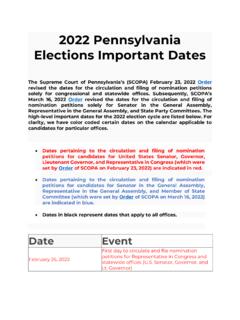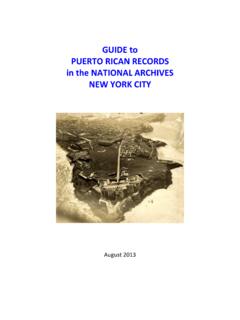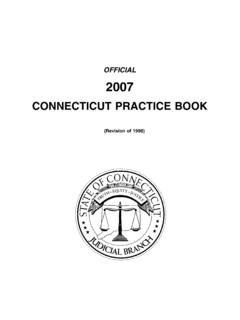Transcription of 2019 AMENDMENTS TO THE 1997 RULES OF CIVIL ... - Lawphil
1 2019 AMENDMENTS TO THE 1997 RULES . OF CIVIL PROCEDURE ( NO. 19-10-20-SC). COVER PAGE. A Publication of the supreme court of the Philippines Cover design by American Bar Association Rule of Law Initiative funded by USAID. Layout and design by RPLO of the Philippine Judicial Academy Copyright 2020. MESSAGE. RULES of procedure are a fundamental part of a judicial system. They act as a vital link that connects the domain of substantive law with that of judicial administration. They ensure that the results of court issuances and processes are valid and legitimate. They guarantee that the application of the law in relation to the rights and liberties of the public is not only accurate but also orderly, timely, and intelligible. In line with this, the supreme court of the Philippines has made it Its perennial objective to constantly improve laws on procedure so that the courts may provide e ective service to the public. Upon my assumption into o ce as the 26th Chief Justice of the Philippines last year, I included in my Ten-Point Program for the Judiciary the continuous revision and issuance of RULES of procedure so as to make the law more responsive and accessible to the needs of court -users, and the conduct by the Philippine Judicial Academy (PHILJA).
2 Of more skills-based training for judges and court personnel. This, following what I. saw was the need to institutionalize procedural reforms that will simplify and expedite judicial proceedings. Two of the recent actions taken by the court geared towards this objective of enhancing the e ciency of judicial administration have been the approval of the AMENDMENTS to the RULES of CIVIL Procedure and the RULES on Evidence, both of which took e ect on May 1, 2020. To further enhance the execution and purpose of the amended RULES , the supreme court , through the PHILJA, presents this compilation of the primer on the amended RULES of CIVIL Procedure and RULES on Evidence, the text of the amended RULES , and a comparative matrix of the old vis- -vis the new procedural RULES to assist judges in understanding the key features of the AMENDMENTS . It is my sincere hope that this publication will be of substantial help in furthering the court 's objective of encouraging the speedy, inexpensive disposition of cases as a means of improving the administration of justice.
3 DIOSDADO. IOSDADO. O M. PERALTA. PERAL. Chieff JJustice ustice MESSAGE. The supreme court has been steadfast in applying the Constitutional right to speedy disposition of cases. It is an embodiment of the oft-repeated rule that justice delayed is justice denied. Section 5 (5), Article VIII of the 1987. Constitution states that the supreme court has the power to promulgate RULES concerning pleadings, practice and procedure. Pursuant to such power, the court promulgated the RULES of court , which generally govern the resolution of court cases. Due to the passage of time, technological advancements thrived in our society, such as the expansion of the internet and the use of electronic mail. Similarly, new methods for the speedy resolution of cases, such as alternative dispute resolution and effective pre-trial techniques, were developed. Further, the Philippines has acceded to international conventions that simpli ied the recognition and service of court documents, such as the Apostille Convention and The Hague Service Convention.
4 Over the years, the supreme court , under the auspices of its development partners, has sent judges, justices, and court of icials to different jurisdiction on study visits to acquire information and knowledge on how to address court docket congestion, reduce trial delays, and improve court management. Equally important are the comments and suggestions of stakeholders within and outside the judiciary on the speedy and ef icient disposition of cases. The knowledge acquired and information accumulated are now re lected in the 2019 Revised RULES of CIVIL Procedure and 2019 Revised RULES on Evidence. The 2019 Revised RULES on Evidence and 2019 Revised RULES of CIVIL Procedure were approved by the supreme court En Banc on october 8, 2019 and october 15, 2019, respectively, and became effective on May 1, 2020. The successful implementation of these RULES is one of the Ten-Point Program of Chief Justice Diosdado M. Peralta. Through skills-based training programs under the direction of the Philippine Judicial Academy, Chief Justice Peralta rightfully believes that these RULES effectively address the problem of court delays.
5 The members of the Subcommittees on the Revision of the 1997 RULES of CIVIL Procedure and RULES on Evidence and the Committee on the Revision of the RULES of court , when these Proposed RULES were formulated, drafted, and eventually approved, were always guided by the principle that an effective court system should never become stale; it must adapt with the changing times, apply the effective methods of dispute resolution, and there must be continuous training of judges, lawyers and litigants on core values of speedy resolution of cases. With the implementation of the 2019 Revised RULES of CIVIL Procedure and 2019 Revised RULES on Evidence, it is my fervent belief that the search for truth in court litigations will be progressive, modernized, prompt, fair, and just. ALEXANDER. ALEX. XAAN. N DER G. GESMUNDO. Associate Justice Member, Committee on the Revision of the RULES of court Vice Chair, Subcommittee on the Revision of the 1997 RULES of CIVIL Procedure MESSAGE. It is indeed an honor for PHILJA to take part in the media launch for the 2019.
6 AMENDMENTS to the RULES of CIVIL Procedure and the Revised RULES on Evidence, through the production of books compiling the primer, amended texts and comparative matrices of the old and new RULES , and I wish to extend my gratitude to the Chief Justice for entrusting PHILJA with this task. The 2019 AMENDMENTS to the RULES of CIVIL Procedure and Revised RULES on Evidence, which took e ect last May 1, 2020, are manifestations of the supreme court 's commitment constantly to nd ways of improving the e ciency of our courts, by promulgating RULES that not only simplify and expedite court proceedings but also adapt to the needs of the changing world. It is our hope that the books, in both printed and digital versions, will provide the end users an easy reference and better understanding of the changes brought about by the AMENDMENTS . ADOLFO S. AZCUNA. PHILJA Chancellor Contents Message of Chief Justice Diosdado M. Peralta iii Message of Associate Justice Alexander G. Gesmundo iv Message of PHILJA Chancellor Justice Adolfo S.
7 Azcuna v 1. Primer on the 2019 AMENDMENTS 1. to the 1997 RULES of CIVIL Procedure 2. Laws on the supreme court 5. A. Act No. 136 (June 11, 1901) 6. An Act Providing for the Organization of Courts in the Philippine Islands B. Republic Act No. 296 (June 17, 1948) 24. Judiciary Act of 1948. C. Batas Pambansa Blg. 129 (August 14, 1981) 49. The Judiciary Reorganization Act of 1980. D. The supreme court under the 1987 Constitution 68. 3. 2019 AMENDMENTS to the 1997 RULES of CIVIL Procedure 71. ( No. 19-10-20-SC). 4. Comparative Table of the 1997 RULES of CIVIL Procedure 203. and the 2019 AMENDMENTS 1. Primer on the 2019 AMENDMENTS to the 1997 RULES of CIVIL Procedure Primer on the 2019 AMENDMENTS to the 1997 RULES of CIVIL Procedure How long did the process of amendment take? Who initiated this? In January 2019 during the term of Chief Justice Lucas P. Bersamin, the Committee on the Revision of the RULES of court , also known as the Mother Rule Committee, was reorganized. Then Associate Justice, now Chief Justice, Diosdado M.
8 Peralta, was the Working Chairperson of the Mother Rule Committee. A Subcommittee was created to study the existing RULES and submit amendment proposals to the Mother Rule Committee. The Subcommittee was likewise chaired by then Associate Justice Peralta, and composed of the following members: SC Associate Justice Alexander G. Gesmundo (Vice Chairperson), SC Associate Justice Francis H. Jardeleza, SC Associate Justice Alfredo Benjamin S. Caguioa, court Administrator Jose Midas P. Marquez, CA Associate Justices Fernanda Lampas Peralta and Maria Filomena D. Singh, retired CA Justice Magdangal M. De Leon, Regional Trial court Judge Jose Lorenzo R. Dela Rosa, Metropolitan Trial court Judge Ni o Delvin E. Embuscado, and Attys. Ramon S. Esguerra and Tranquil Gervacio S. Salvador III, among others. The Subcommittee's work was then submitted to the Mother Rule Committee. The Mother Rule Committee reviewed, deliberated on and finalized the proposed AMENDMENTS to the Revised RULES on Evidence and to the 1997 RULES of CIVIL Procedure.
9 The exhaustive study and review of proposed AMENDMENTS were done within eight (8) months, from the time the Mother Rule Committee initially met on February 14, 2019 up to the approval of the proposed AMENDMENTS by the court En Banc on october 8 and 15, 2019. What are the significant changes? The AMENDMENTS to the 1997 RULES of CIVIL Procedure present a multi-faceted adjustment to the RULES , with the goal of improving the flow of court proceedings and avoiding delays. For parties, the requirements to institute an action were modified such that the complaint must now include evidentiary matters, , judicial affidavits and copies of documents. Several motions, which are susceptible to dilatory abuse, are now prohibited or considered non-litigious, while litigious motions may be heard at the judge's discretion. The provision on the hearing of motions was deleted. The entire Rule 16 on motion to dismiss was also deleted, as most of its provisions were incorporated in other RULES . New provisions on the presumptive service of pleadings and other papers, substituted service of summons, and service and filing through accredited courier, email and other electronic means have been introduced to prevent delay in court proceedings.
10 The provision on extraterritorial service has been amended to include modes of service as provided for in international conventions to which the Philippines is a party, , Convention on the Service Abroad of Judicial and Extrajudicial Documents in CIVIL or Commercial Matters, commonly known as The Hague Service Convention. The AMENDMENTS also require judges to be more engaged as they take on a more proactive role in assessing the merits of cases and the progress of proceedings in general. 2 2019 AMENDMENTS TO THE 1997 RULES OF CIVIL PROCEDURE ( NO. 19-10-20-SC). The practice of having a preliminary conference before the branch clerk of court was done away with, and pre-trial shall be immediately conducted by the judge. Pre-trial now needs to be concluded before the case is referred to court -Annexed Mediation (CAM), but only (1) if there is a genuine issue involved; (2) if the answer tenders an issue; or (3) if the answer does not admit the material allegations in the adverse party's pleadings.






